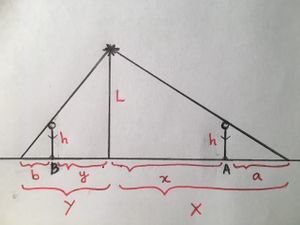Science:Math Exam Resources/Courses/MATH100/December 2016/Question 11 (a)
{{#incat:MER QGQ flag|{{#incat:MER QGH flag|{{#incat:MER QGS flag|}}}}}}
• Q1 (a) • Q1 (b) • Q1 (c) • Q2 (a) • Q2 (b) • Q2 (c) • Q2 (d) • Q3 (a) • Q3 (b) • Q3 (c) • Q4 (a) • Q4 (b) • Q4 (c) • Q5 (a) • Q5 (b) • Q5 (c) • Q6 (a) • Q6 (b) • Q7 (a) • Q7 (b) • Q8 • Q9 (a) (i) • Q9 (a) (ii) • Q9 (a) (iii) • Q9 (b) (i) • Q9 (b) (ii) • Q9 (b) (iii) • Q9 (c) (i) • Q9 (c) (ii) • Q9 (c) (iii) • Q10 (a) • Q10 (b) • Q11 (a) • Q11 (b) • Q12 • Q13 (a) • Q13 (b) • Q14 (a) • Q14 (b) •
Question 11 (a) |
|---|
|
and , two people of identical height , stand beneath a street lamp of height . walks in a straight line and at a constant speed away from the street lamp. One second later, walks in a straight line and at the same speed, but in the opposite direction, away from the street lamp. As and move away from the lamp, their shadows grow longer. (a) Let be the length of ’s shadow, and be the length of ’s shadow. Let be the distance has walked, and be the distance has walked. Draw and label a picture that illustrates the scenario two seconds after begins to walk away from the street lamp. Your picture should indicate all relevant lengths and the associated variables. |
|
Make sure you understand the problem fully: What is the question asking you to do? Are there specific conditions or constraints that you should take note of? How will you know if your answer is correct from your work only? Can you rephrase the question in your own words in a way that makes sense to you? |
|
If you are stuck, check the hint below. Consider it for a while. Does it give you a new idea on how to approach the problem? If so, try it! |
Hint |
|---|
|
Science:Math Exam Resources/Courses/MATH100/December 2016/Question 11 (a)/Hint 1 |
|
Checking a solution serves two purposes: helping you if, after having used the hint, you still are stuck on the problem; or if you have solved the problem and would like to check your work.
|
Solution |
|---|
 Note that you may not have and in your diagram. |
{{#incat:MER CT flag||
}}










